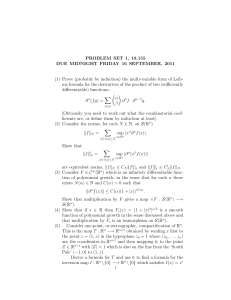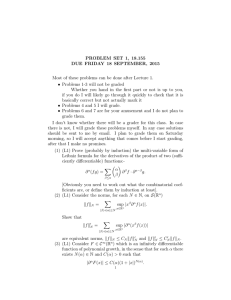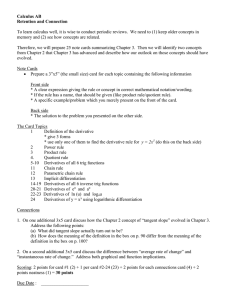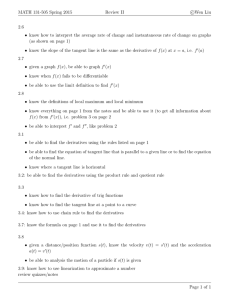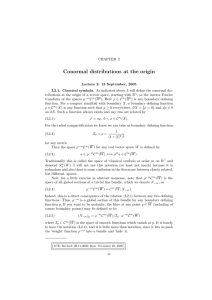PROBLEM SET 1, 18.155 BRIEF SOLUTIONS
advertisement
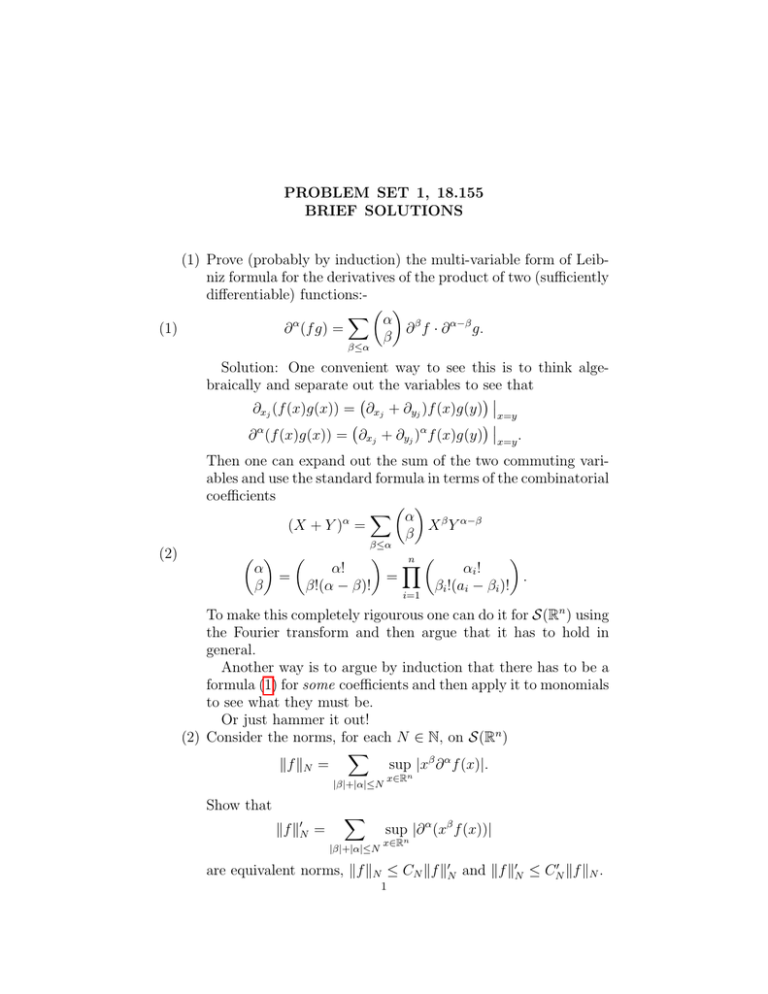
PROBLEM SET 1, 18.155
BRIEF SOLUTIONS
(1) Prove (probably by induction) the multi-variable form of Leibniz formula for the derivatives of the product of two (sufficiently
differentiable) functions:X α
α
(1)
∂ (f g) =
∂ β f · ∂ α−β g.
β
β≤α
Solution: One convenient way to see this is to think algebraically and separate out the variables to see that
∂xj (f (x)g(x)) = ∂xj + ∂yj )f (x)g(y) x=y
∂ α (f (x)g(x)) = ∂xj + ∂yj )α f (x)g(y) x=y .
(2)
Then one can expand out the sum of the two commuting variables and use the standard formula in terms of the combinatorial
coefficients
X α
α
X β Y α−β
(X + Y ) =
β
β≤α
Y
n α
α!
αi !
=
=
.
β
β!(α − β)!
βi !(ai − βi )!
i=1
To make this completely rigourous one can do it for S(Rn ) using
the Fourier transform and then argue that it has to hold in
general.
Another way is to argue by induction that there has to be a
formula (1) for some coefficients and then apply it to monomials
to see what they must be.
Or just hammer it out!
(2) Consider the norms, for each N ∈ N, on S(Rn )
X
kf kN =
sup |xβ ∂ α f (x)|.
|β|+|α|≤N
x∈Rn
Show that
kf k0N =
X
|β|+|α|≤N
sup |∂ α (xβ f (x))|
x∈Rn
are equivalent norms, kf kN ≤ CN kf k0N and kf k0N ≤ CN0 kf kN .
1
2
PROBLEM SET 1, 18.155 BRIEF SOLUTIONS
Solution: Use induction over N. We can apply Leibniz’ formula to see that
X
0
0
∂ α (xβ f ) = xβ ∂ α f +
cα0 ,β 0 xβ ∂ α f
β 0 <β, α0 <α
since as soon as one derivative falls on the coefficients the order
drops in both senses. Each of the terms in the sum is bounded
by the N − 1 norm, so, using the inductive hypothesis
|∂ α (xβ f )| ≤ |xβ ∂ α f | + Ckf kN −1 , |xβ ∂ α f | ≤ |∂ α (xβ f )| + Ckf k0N −1 .
Taking the supremum and summing over α and β gives the
inductive step.
(3) Consider F ∈ C ∞ (Rn ) which is an infinitely differentiable function of polynomial growth, in the sense that for each α there
exists N (α) ∈ N and C(α) > 0 such that
|∂ α F (x)| ≤ C(α)(1 + |x|)N (α) .
Show that multiplication by F gives a map ×F : S(Rn ) −→
S(Rn ).
Solution: Again this is an application of Leibniz’ formula.
The product F φ with φ ∈ S(Rn ) is infinitely differentiable with
X
X
0
0
0
cα0 |xβ ∂ α F ||∂ α−α φ| ≤ C
|xβ ∂ α (F φ)| ≤
C(1+|x|)N ∂ α φ| ≤ kφ|M
α0 ≤α
α0 ≤α
where the power N is the max of |β| + N (α0 ) and this determines M. Taking the supremum, ×F : S(Rn ) −→ S(Rn ) is a
continuous linear map.
(4) Show that if s ∈ R then Fs (x) = (1 + |x|2 )s/2 is a smooth
function of polynomial growth in the sense discussed above and
that multiplication by Fs is an isomorphism on S(Rn ).
Solution: To see that this function is of polynomial growth,
prove the stronger symbol estimates
(3)
|∂ α Fs (x)| ≤ Cs,α Fs−|α| .
These follow by using induction to check that
(4)
∂ α Fs (x) = pα (x)Fs−2|α|
where pα is a polynomial of degree at most |α| so |pα | ≤ Cα F|α| .
Now F0 = 1 and Ft+s = Fs Ft so the inverse of ×Fs is ×F−s
and it follows that multiplication is an isomorphism.
(5) Consider one-point, or stereographic, compactification of Rn .
This is the map T : Rn −→ Rn+1 obtained by sending x first to
the point z = (1, x) in the hyperplane z0 = 1 where (z0 , . . . , zn )
PROBLEM SET 1, 18.155
BRIEF SOLUTIONS
3
are the coordinates in Rn+1 and then mapping it to the point
Z ∈ Rn+1 with |Z| = 1 which is also on the line from the ‘South
Pole’ (−1, 0) to (1, x).
Derive a formula for T and use it to find a formula for the
inversion map I : Rn \{0} −→ Rn \{0} which satisfies I(x) = x0
if T (x) = (z0 , z) and T (x0 ) = (−z0 , z). That is, it correspond to
reflection across the equator in the unit sphere.
Solution: Since Z = T x has |Z| = 1 and Z = (1 − s)(−1, 0) +
s(1, x) for some s,
4
(2s − 1)2 + s2 |x|2 = 1 =⇒ s =
,
4 + |x|2
4x
4 − |x|2
,
Tx =
4 + |x|2 4 + |x|2
since the other root, s = 0, is the South Pole. Then
4 − |x|2
4x
4x
0
Tx = −
,
=⇒
x
=
Ix
=
.
4 + |x|2 4 + |x|2
|x|2
0
Show that if f ∈ S(Rn ) then I ∗ f (x) = f (x0 ), defined for
x 6= 0, extends by continuity with all its derivatives across the
origin where they all vanish.
Solution: Certainly I is smooth and is a diffeomorphism of
the region Rn \ {0} to itself, since it has inverse I – from the
definition it is an involution so I ∗ f (x) = f (4x/|x|2 ) is smooth
outside the origin. As |x| → 0, |Ix| → ∞ and f ∈ S(Rn ), so
I ∗ f extends continously up to 0 where it vanishes. The chain
rule gives the formula for the first derivatives of I ∗ f :
(5)
∗
∂xj I f =
n
X
gjk (x)I ∗ (∂yk f ), gjk = ∂xj
k=1
(6)
4xk
.
|x|2
We can work out the coefficients, but the important thing is that
they are smooth functions in |x| > 0 which are homogeneous of
degree −2. Here the ∂yk f are the derivatives of f. Now, one can
get the higher derivatives by differentiating inductively and it
follows that
X
∂xα I ∗ f =
gα,β (x)I ∗ (∂yβ f )
|β|≤|α|
4
PROBLEM SET 1, 18.155 BRIEF SOLUTIONS
where the coefficients are smooth in |x| > 0 and homogeneous
of degree −2|α| + |β|. This means we get estimates near 0
X
|∂xα I ∗ f (x)| ≤ C
|x|−2|α|+|β| |I ∗ (∂yβ f )|.
|β|≤|α|
(7)
However, f being Schwartz means that |I ∗ f (x)| ≤ CN |x|N for
any N and the same thing applies to the derivatives. So in fact
we conclude that all the derivatives of I ∗ f extends continuously
across the origin and vanish there (to infinte order as follows
anyway). This means I ∗ f itself is smooth as claimed with all
derivatives vanishing at 0.
Conversely show that if f ∈ C ∞ (Rn ) is a function with all
derivatives continuous, then f ∈ S(Rn ) if I ∗ f has this property,
that all derivatives extend continuously across the origin and
vanish there – i.e. they all have limit zero at the origin.
Solution: Just reverse the argument. All we need so show is
that xβ ∂xα is bounded for all α, β. Since I is its own inverse, (5)
gives
X
∂yα f (y) =
gα,β (y)∂xβ (I ∗ f )
|β|≤|α|
where the same statements apply, except now we are interested
in what is happening as |y| → ∞. However, using homogeneity
and now the fact that all derivatives of I ∗ f have bounds CN |x|N
for any N, we find that in |y| > 1,
(8)
|∂yα f (y)| ≤ CM |y|−M
for any M. So indeed the converse is also true.
